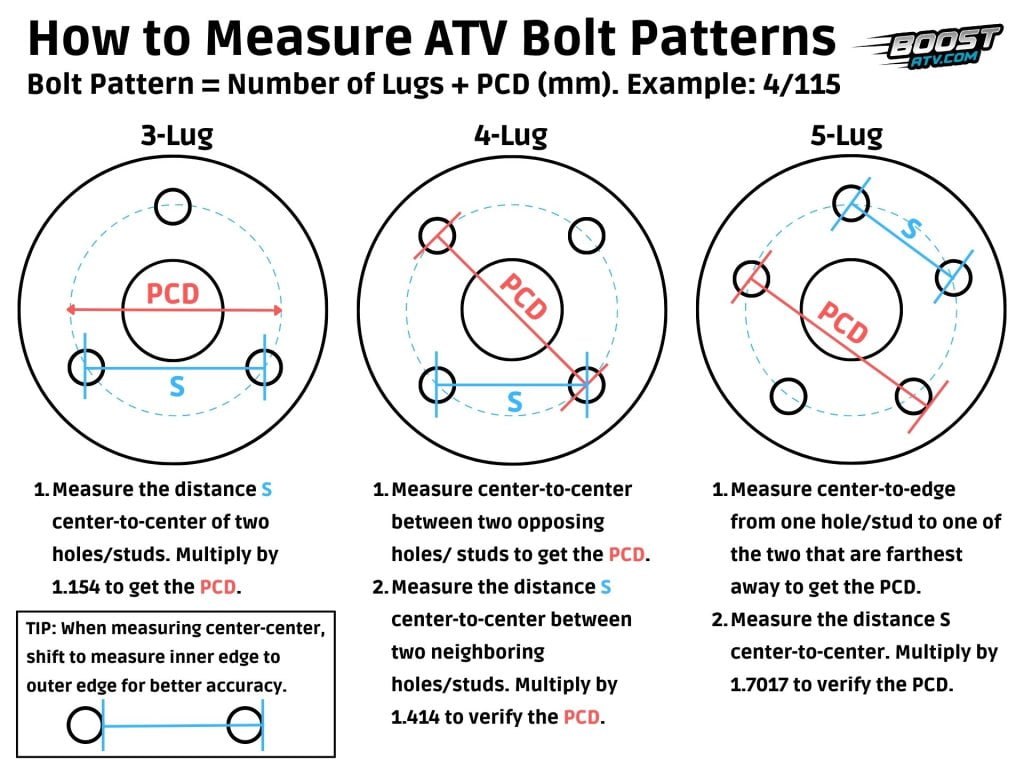Unlocking Your Wheels: Mastering 4-Lug Bolt Pattern Measurement

Ever found yourself staring at a wheel, wondering about the mysteries hidden within its bolt pattern? It's a crucial piece of information, especially when replacing or upgrading rims. For those with 4-lug wheels, determining the bolt pattern is a straightforward process, once you understand the fundamentals.
Imagine buying a set of sleek new rims, only to discover they don't fit your car. This frustrating scenario can be easily avoided by knowing how to ascertain your 4-lug bolt pattern. This seemingly small detail has a significant impact on wheel compatibility and overall vehicle safety.
The bolt pattern, sometimes called Pitch Circle Diameter (PCD), defines the arrangement of the lug holes on the wheel. It's expressed as a number followed by the unit of measurement (e.g., 4x100, meaning 4 lug holes on a 100mm diameter circle). Understanding this measurement is fundamental for anyone working with wheels, from car enthusiasts to professional mechanics.
Measuring a 4-lug bolt pattern is generally easier than with more lugs. The process involves measuring the distance between the center of one lug hole to the center of the opposite lug hole. For 4-lug patterns, this direct measurement provides the PCD. However, it’s crucial to measure accurately to avoid compatibility issues.
Historically, bolt patterns have evolved alongside automotive advancements, with different manufacturers adopting various standards. Understanding the origin and evolution of these patterns provides valuable context for appreciating the importance of accurate measurement. Inaccurate measurements can lead to improper wheel fitment, potentially causing vibrations, premature wear, and even safety hazards.
To measure a 4-lug bolt pattern, locate the center of two opposite lug holes. Using a ruler or caliper, measure the distance between these centers. This measurement is your bolt pattern.
Benefits of knowing how to determine a 4-lug bolt pattern include:
1. Confident Wheel Purchasing: Ensures you buy compatible rims, avoiding returns and frustration. For example, knowing your car requires a 4x100 bolt pattern prevents accidentally purchasing 4x114.3 rims.
2. Enhanced Safety: Correctly fitted wheels are essential for safe driving. An incorrectly fitted wheel could come loose, posing a serious safety risk.
3. Improved Vehicle Performance: Properly fitted wheels contribute to optimal vehicle handling and performance.
Step-by-step Guide to Measuring a 4-Lug Bolt Pattern:
1. Clean the mounting surface of the wheel.
2. Identify two opposite lug holes.
3. Measure the distance between the centers of these holes with a ruler or caliper.
4. Record the measurement.
Advantages and Disadvantages of Measuring Your Own Bolt Pattern
| Advantages | Disadvantages |
|---|---|
| Saves time and money by avoiding a trip to a mechanic. | Potential for inaccurate measurement if not done carefully. |
Best Practices:
1. Use a precise measuring tool like a digital caliper for accurate readings.
2. Double-check your measurements to minimize errors.
3. Consult online resources or a professional if unsure.
4. Clean the wheel hub before measuring to ensure accurate readings.
5. Understand the difference between metric and imperial measurements (mm vs. inches).
FAQs
1. What is a bolt pattern? A bolt pattern is the arrangement of lug holes on a wheel.
2. Why is it important to know my bolt pattern? It ensures you purchase compatible wheels.
3. How do I measure a 4-lug bolt pattern? Measure center-to-center of opposite lug holes.
4. What tools do I need? A ruler or caliper.
5. What if my measurement isn't a whole number? Round to the nearest whole number.
6. Where can I find my car's bolt pattern information? Owner's manual or online resources.
7. What happens if I use the wrong bolt pattern? It can lead to safety hazards and damage.
8. Can I change my car's bolt pattern? It is generally not recommended and can be complex.
Tips and Tricks:
For slightly corroded or dirty wheels, a wire brush can help clean the lug hole centers for a more accurate measurement.
Knowing how to measure a 4-lug bolt pattern empowers you to make informed decisions about your wheels. This seemingly simple skill can prevent costly mistakes, ensure your safety on the road, and even contribute to optimal vehicle performance. By understanding the importance of accurate measurement and following the simple steps outlined in this guide, you can confidently navigate the world of wheel replacements and upgrades. Take the time to measure accurately, double-check your work, and consult resources when needed. Your wheels, and your safety, will thank you. This knowledge translates to peace of mind, knowing your wheels are securely attached and contributing to a smooth, safe, and enjoyable driving experience. So, grab your measuring tool, inspect your wheels, and unlock the secrets of your 4-lug bolt pattern today!
Mastering your boats electrical system with waterproof rocker switch panels
Unleash the laughter hilarious birthday songs for grown ups
Benjamin moore blue gray paint colors that will make you swoon













